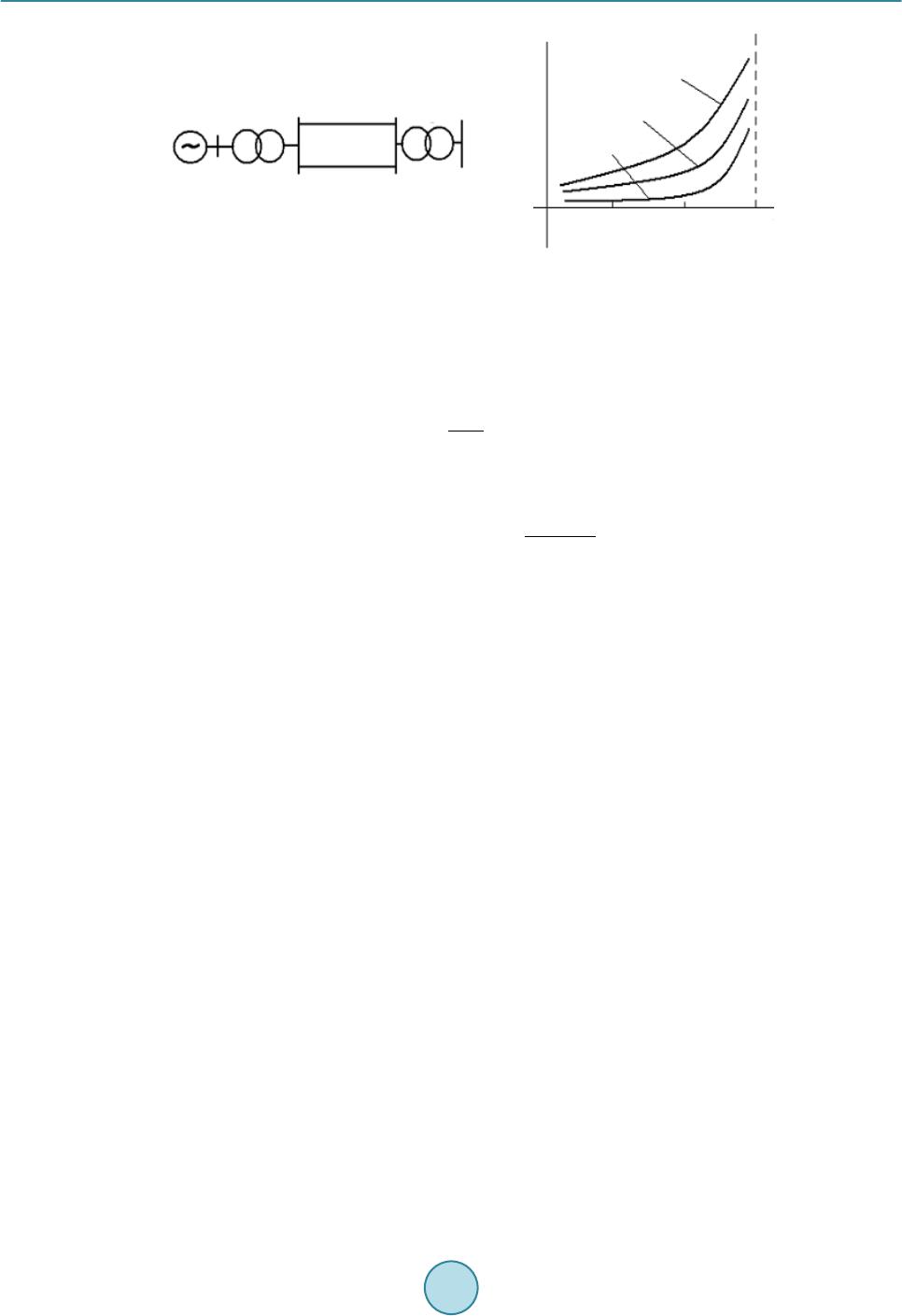 Journal of Power and Energy Engineering, 2015, 3, 224-231 Published Online April 2015 in SciRes. http://www.scirp.org/journal/jpee http://dx.doi.org/10.4236/jpee.2015.34031 How to cite this paper: Allaev, K.R., Mirzabaev, A.M., Makhmudov, T.F. and Makhkamov, T.A. (2015) Simplified Criterion of Steady-State Stability of Electric Power Systems. Journal of Power and Energy Engineering, 3, 224-231. http://dx.doi.org/10.4236/jpee.2015.34031 Simplified Criterion of Steady-State Stability of Electric Powe r Sy ste ms K. R. Allaev1, A. M. Mirzabaev2, T. F. Makhmudov3, T. A. Makhkamov4 1Power Engineering D epa rtm ent, Tashkent State Technical Un ive rsit y, Tashkent, Republic of Uzbekistan 2Mir Solar LLC, Tashkent, Republic of Uzbekistan 3Power Engineering D epa rtm ent, Tashkent State Technical Un ive rsit y, Tashkent, Republic of Uzbekistan 4Research and De velop ment Depar tment , Tec on Groups, Mosco w, Russian Fed erati on Email: solarmir@mail.ru, temur.ma@gmail.com Received January 2015 Abstract In the paper the simplified criterion of a steady-state stability of electric power systems (EPS) is justified on the basis of Lyapunov functions in a quadratic form ensuring necessary and sufficient conditions of its performance. Upon that, the use of the node-voltage equations allows reducing study of a steady-state stability of complex EPS to study of the generator-bus system. The obtained results facilitate studies of a steady-state stability of the complex systems and have practical im- port ance . Keywords Steady-State Stability, Matrix Method, Lyapunov Function, Node -Voltage Equations 1. Introduction Study of EPS stability at small disturbances is based on known classical concepts of the General Theory of Sta- bility of Motion [1]-[8]. As is known [1]-[4] [7], features of EPS are their continuous flow process, complexity, multiple connection of system of facilities and their control devices. With increasing the capacity and complexity of EPS the problem of automation of system state control both in normal operating conditions and during disturbances becomes more acute. Development of the automated dispatch control systems (ADCS) for EPS and automatic control systems require the new approach to development of the simplified mathematical models and the algorithms meeting the practical requirements that form the basis of complex EPS control [1] [4] [7] [8]. There is a real-time calculation problem when the issue to ensure maximum operativeness of a current oper- ating conditions stability calculation and timely definition of EPS approaching to stability limits is critical. The most acceptable for their solution are the matrix computational methods grounded on use of the newest methods to discover structural properties of dynamic systems which include modern electric systems [7]-[11]. Steady-state stability study of electric power systems consists in definition of a possibility of steady-state op- eration under given values of electric power system’s parameters, an electricity generating sources operation state, loads in nodal points and settings of automatic control equipment [1] [2]. The problem is usually solved  K. R. Allaev et al. for the determined conditions. In most cases the complex power system steady-state stability analysis is carried out under the supposition of the lack of a self-oscillation in the electric power system considering that this requirement is ensured by appro- priate setting of automatic regulators [3]. In this case the problem becomes simpler and is reduced to study of an aperiodic steady-state stability of the system, i.e. to definition of dependence and a sign for the constant term of the characteristic equation of the system upon the continuous variation of any parameter of the operation condi- tion. Now, except for classical, direct solution methods for calculation of a matrix spectrum of system are also used for complete steady-state stability analysis, including an estimate of lack of eigenvalues in the right half-plane by indirect criteria, dynamic simulation methods, etc. [11]. In the practice of calculations there is the popular method of so-called critical sections when the critical line (section) is determined by high probability of loss of EPS stability because of overloading. Upon that, finally it is not specified what generator or station are referred to the critical section, therefore definition of critical sec- tion is ambiguous [12]. The devices of the synchronized phasor measurement units (SPMU) being developed create premises for de- velopment of new analysis methods and algorithms of an electric power system state at small disturbances in- cluding methods to detect weak tie-lines and critical sections that are based exclusively on operatively obtained values of operating condition parameters [7]. 2. Lyapunov Function in a Quadratic Form as the Tool for the Full Study of Steady-State Stability in EPS One of the most fruitful methods for study of EPS stability is application of a direct (second) Lyapunov’s me- thod which require selection of special Lyapunov functions and obtaining of their derivatives taking into account the perturbation equations [5] [6]. According to Lyapunov’s direct method which is applied to study of a dynamic systems stability including electrical power systems it is generally supposed definition of special sign-definite function of state variables which derivative taken on account of system of differential equations describing dynamics of the system, should be sign-definite with an opposite sign to V or be identically zero or strictly sign-definite with an opposite sign to V. Under these requirements the system is, accordingly, stable or asymp- totically stable [5] [6]. Construction of V for nonlinear systems is generally performed by a trial method and ob- tained results ensure only sufficient conditions of stability for the explored system. At the same time, in the case of linear autonomous systems there is a Lyapunov function in a quadratic form ensuring both necessary and sufficient conditions of its stability [5]. Modern counting machines offer ample opportunities for a solution of the higher order equations [13] and, accordingly, successful application of Lya- punov functions in a quadratic form for study of a steady-state stability for complex EPS [14]. The essence of the method consists in the following. Let’s consider the linear time-invariant system described in a state space by the system of differential equations: (1) where A is a square matrix with constant elements; X is a n—dimensional column vector with coordinates . Following Lyapunov, we will define for this system function V in a quadratic form [5] [6]: T ,1 ,,1, 2,, n ij ij ij Vqx xXQXijn = = == ∑ (2) where Q is yet unknown square matrix of coefficients of a quadratic form; XT is transposed X (row-vector). Owing to (1) the total derivative of V with time looks like: (3) Let’s require that V should satisfy the condition: (4)  K. R. Allaev et al. where W is arbitrarily prescribed quadratic form of state variables. Let’s denote: (5) The main result consists in that the system (1) is asymptotically stable in only case when the (2) has positive definite solutions Q at any positive definite matrix C [5]. The Equation (5) puts in correspondence to any symmetric matrix Q a matrix C and vise versa, and this cor- respondence is linear [5] [17]. Elements of matrix Q are determined from (5) by a solution of equa- tions where n is a number of initial differential equations. If to set a positive definite symmetric matrix C (where the determined from (5) matrix Q will be also positive definite) then due to linearity and stationarity of system (1), according to the Lyapunov’s theorem, we will obtain an asymptotical stability of its equilibrium state. Upon that, stability conditions should be strictly equivalent to the obtained on the basis of Routh-Hurwitz criterion [2]. There is a close connection between the Lyapunov’s theorem and other algebraic stability criteria: the Routh- Hurwitz criterion [15], the Hermite stability criterion [16], the Shur-Kon criterion [17], and the constituent ma- trix method [18] [19]. The main advantage of the Lyapunov’s second method for stability when studying stabil- ity conditions is related to a possibility to operate in calculations with elements of a matrix A omitting calcula- tions of coefficients of a characteristic polynomial for this matrix. On the basis of Lyapunov’s functions in a quadratic form, we will carry out computational-experimental re- search of a steady-state stability of both simplex and complex EPSs and compare results for them with the re- sults obtained conventionally on the basis of the Routh-Hurwitz criterion. 2.1. Simplex EPS The characteristic equation at small fluctuations of operating condition parameters at study of a steady-state sta- bility of the simplex uncontrolled EPS (Figure 1(a)) taking into account transients in a field winding looks like [2] [14]: (6) where a0, a1, a2, a3 are the coefficients of a characteristic equation which are functions of operating condition parameters and EPS. In our case Lyapunov function in a quadratic form at according to (2) looks like: T 222 11122233 3121 213 1 32323 222 VXQXqx qxqxqxxqxxqxx = =+++++ (7) Let set C in the form of an identity matrix. Then (8) Upon that, the matrix of coefficients of a quadratic form (7) according to (2) looks like: 11 1213 21 2223 31 31 33 qqq Qqqq qqq = (9) We have set negatively definite derivative W (positively definite symmetric C). If upon that the positive defi- niteness requirements to the matrix Q of a quadratic form (7) are satisfied then initial system equilibrium state asymptotic stability conditions (1) will be obviously provided. For the positive definiteness of a quadratic form (7) according to Sylvester’s criterion [5] [6] it is necessary and sufficient that principal diagonal minors of matrix Q were positive: 11 1213 11 12 1112321 2223 21 2231 31 33 0; 0;0 л лл qqq qq q qqq qq qqq ∆= >∆=>∆=> (10)  K. R. Allaev et al. (a) (b) Figure 1. Behavior of minors of a quadratic form for the matrix Lyapunov equation (b) for the EPS circuit design (a). Let’s start checking violation of positivity of these minors with the first . As disclosing ∆л1 shows, the minor can become negative if following requirements [14] are broken: (11) (12) (13 ) where is the real output power of the generator at ., U is the terminal voltage of the generator, is EMF of the generator, , , are synchronous and transient reactance of the synchronous ge- nerator and reactance of the transmission line, accordingly, is the torque angle of the generator that deter- mines stability of the generator and therefore, EPS, is a complementary angle [2] [3] [14]. The requirement (11) can be broken only in the case of overload which may cause an aperiodic instability of EPS. Violation of the inequality (12) is possible in the case of overcompensation of an reactance of the power line by the direct compensation plants (series capacitances) that leads to electromagnetic instability in a power sys- tem (self-excitation of generator). The requirement (13) can be broken in operating conditions close to light load conditions and synchronous generator operation with a transmitting line with appreciable resistances and thereby a stability violation process has oscillatory behavior and is observed in the form of electromechanical oscillation of the generator rotor (self -oscillation). In other words, requirements to violation of positivity of the first minor in a square matrix (10) imply all possible conditions that may lead to violation of an electrical power system steady-state stability, i.e., the com- plete problem to define conditions of EPS instability is solved “in the small”. The analysis has shown [14] [20] that positivity of , is reduced to satisfaction of the same re- quirements (11)-(13). So, conditions that may lead to violation of an electrical power system steady-state stability obtained by Lya- punov’s second method coincide with earlier discovered on the basis of the generalized Routh-Hurwitz condi- tions. It is necessary to note that for the first time requirements of adequacy of the results obtained on the basis of Lyapunov functions in a quadratic form and a Routh-Hurwitz criterion for an electrical power system have been obtained in the work [20]. With a view of checking theoretical rules there were carried out computational-experimental researches of vi- olation of principal minors positivity in a quadratic matrix (10). Calculations were carried out for the simplex and complex EPS [14]. Calculations were also carried out on the basis of the Routh-Hurwitz criterion аor the purpose of comparison.  K. R. Allaev et al. Figure 1(b) shows variations of minors (10) at gradual increasing the load in EPS (increasing the transmitted real power). The analysis shows that upon increasing the operation condition loads variations for all minors from the matrix of a quadratic form of Lyapunov function (10) have the equal character, while variations of characteristic equation coefficients (6) and Hurwitz determinants are absolutely different [14]. The result allows using positivity of the first minor, i.e . , for complete analysis of a steady-state sta- bility of the electrical power system because q11 contains all information on possible kinds of EPS instability “in the small”. Upon that, positivity of the higher minors, i.e. > 0 ( ; where n is the order of a diffe- rential equation of initial EPS) may not be considered in the first approximation. Hence, it is possible to state simplified (practical) criterion of a steady-state stability q11 > 0 which gives both necessary and sufficient condi- tions of its performance. Traditionally [2], these requirements are obtained on the basis of positivity of characte- ristic equation coefficients for the system (the necessary condition) and positivenesses of Routh-Hurwitz matrix determinants (the sufficient condition). 2.2. Complex EPS The calculation analysis of a steady-state stability for EPSs of various complexity shows [4] that the most strict in theoretical aspect, convenient in computing aspect and effective aspect by the obtained results is use of two fundamental methods: the method of Lyapunov functions in a quadratic form and the method of the nodal equa- tions [14] [21]. The proposed stability research technique “in the small” has been suggested for the first time in the work [22], and its essence consists in the following. When studying a steady-state stability of complex EPS, calculation of the steady-state condition on the basis of the node-voltage equations is carried out at first, voltages Uk for each node k and their arguments δk, and further for each j-th generator are determined; then positivity of the first minor q11j (10) of the matrix of qua- dratic form Q is checked using these data. Thereby the stability of the generator which is the fastest to come closer to a limit at the given load is determined. In essence, stability study “in the small” of the complex EPS using the proposed method turns to study of the generator-bus system. Let’s consider steady-state stability conditions of complex EPS by the example of three-generator system (Figure 2) since such model of the electrical power system as a whole adequately reflects properties and per- formances of the complex electrical system [4] [23] [24]. Figure 3 represents characters of variations (where ) of the first elements of minors for ma- trixes of quadratic forms for each generator of the system in question. Changes (increasing) of minors of a quadratic form for different generators in the case if loading of oper- ating conditions of the electrical power system increases are different, that is clear from Figure 3. Upon condition if the small deviations of EPS operating condition parameters are constant (∆П = constant) it is possible to write: 32131 1 and hhh ξξξ ∆∆∆ (14) where are the incremental rates of first minors of quadratic form matrixes for each generator showing how quickly a generator comes closer to the stability limit. The analytical expression , for example, for the second generator at i-th step looks like: Figure 2. The circuit design of three-generator electrical power system.  K. R. Allaev et al. Figure 3. Definition of the steady-state stability simplified criterion for the complex EPS (П is the operating condition parameter of EPS). ( ) ( ) ( ) 2, 21 2 22, 2, 121 ii i ii i h ξ + ++ ∆ −∆ ∆= =∆ ∆ΠΠ− Π (15) Generally (15) looks like: ( ) ( ) ( ) 1 ,1 1 ji ji j jji jijjj i h ξ + ++ ∆ −∆ ∆= =∆ ∆ΠΠ−Π (16 ) where П → U, f, I, , etc. are the operating condition parameters of EPS by which variations of minors for generators of the explored system as a result of increasing the loads of operating conditions can be determined, j is the generator for which (16) is calculated, i is a current step of increasing the loads for the given EPS operat- ing condition parameter. Let’s transfer to differentials under condition of small increments: (17) The condition for a quadratic form is always satisfied, therefore it is possible to be restricted to study of strict performance of the inequality: ( ) ( ) 11 1, 1 d0 d ji ji j jji i ji q h+ + ∆ −∆ ∆=∆= Π −ΠΠ (18) The condition (18) means that in order to provide a steady-state stability of j-th generator and, hence, EPS, the fulfillment of the following condition is required: (19) On the basis of the obtained results it is possible to propose the following algorithm for studies of a steady- state stability of the complex electric power systems. With increasing the load by the given parameter of operating condition П at each step i and for each generator or the selected groups of generators the condition (19) is checked and compared with other similar conditions, i.e., fulfillment of conditions is checked: 11,1 11,1 11, ddd ddd n qqq ΠΠΠ (20)  K. R. Allaev et al. where n is a number of generators or stations checked on a steady-state stability. The generator which first minor variation in a matrix of coefficients of a quadratic form is maximum will be the most critical from the point of view of steady-state stability violation: (21) for the considered series of generators. Hence, j-th generator for which will be the first which comes to a steady-state stability limit of EPS. Thus, that generator which tends to steady-state stability violation, and also possible sections (lines) which represent the greatest danger from this point of view should be determined at first. The given factor is valuable also in that it allows to define the corresponding parameter of operating conditions which is most preferable to control the transient behavior of EPS in the case of regulation. This makes it possible to organize control of transient process of the generator using automatic excitation control, automatic speed control and other control systems and proactively ensure its steady-state stability. The significance of this result is obvious to practice of maintenance of electric power systems. This data imply efficiency of common application of the nodal equations and Lyapunov functions in a qua- dratic form and prospectivity of the proposed method for study of a steady-state stability of complex EPS. 3. Conclusions The obtained theoretical and computational results confirmed for systems of various complexity allow checking stability of EPS “in the small” by study of positivity condition for the first minor of a Lyapunov function matrix in a quadratic form and to consider it as the practical (simplified) criterion of EPS steady-state stabil- ity providing its both necessary and sufficient conditions. Definition of the requirement al- lows the generator to reveal that represents the greatest danger from the point of view of stability violation. Upon that, the study of a steady-state stability of the complex EPS turns to study of the “generator-bus” circuit design that makes it possible to determine the particular generator or station which leads to violation of a system stability and an asynchronous condition in system. Thus, joint use of Lyapunov functions in a quadratic form and the node-voltage equations allows us to the fullest extent to explore a steady-state stability of the complex electrical power system including both its elec- tromechanical and electromagnetic violations. References [1] Rudenko, Y.N. and Semyonova, V.A. (2000) Automation of Dispatch Control System in Electrical Power System. MPEI, Moscow. [2] Venikov, V.A. (1964 ) Transient Phenomena in Electrical Power System. Pergamon Press, Macmillan, New York. [3] Barinov, V.A. and Sovalov, S.A. (1990) Electrical Power Systems Operating Conditions: Analysis and Control Method. Energoatomizdat, Moscow. [4] Anderson, P.M. and Fouad, A.A. (2003) Power System Control and Stability. 2nd Edition, IEEE, Wiley-Interscienc e, USA. [5] Barabashin, E.A. (1970) Lyapunov Function. Science, Moscow. [6] Andreev, Y.N. (1976) Finite-Dimensional Linear Object Control. Science, Moscow. [7] Misrikhanov, M.Sh. and Ryabchenko, V.N. (2006) Solution of Algebraic Systems with Local Variable Matrix for Dis- patching Control in EPS. A&T, 5, 131-14 1. [8] Vasin, V.P., Starshinov, V.A. and Domnina, V.V. (2006) Application of New Processing Technology in Electrical Power System Control. MPEI. [9] Bukov, V.N. (20 06) Syst em ’s E mbedding. Analytical Approach to Analysis and Design of Matrix Systems. Kaluga. [10] Asanov, A.Z. (2007) S yst em’s Embedding Method and Its Application. USATU, Ufa. [11] Misrikhanov, M.Sh. and Ryabchenko, V.N. (2006) Quadratic Problems of Eigenvalue in EPS. A&T, 5, 24-47. [12] Narovlyanskiy, V.G. and Kurmak, V.V. (2012) The Critical Section Determination Algorithm in EPS in the Design of Emergency Automatics. Electric Power Plant, 3, 48-51.  K. R. Allaev et al. [13] Alalishev, O.S. (2004) Super Computers: Field of Application and Performance Requirements. Electro nics, 1. [14] Allaev, K.R. and Mirzabaev, A.M. (2011) Small Fluctuations of Electrical Power System. Matrix Approach. Science and Technologies, Academy of Sciences Republic of Uzbekistan, Tashkent. [15] Kalman, R.E. (1695) On the Hermite-Fujiwara Theorems in Stability Theory. Quarterly of Applied Mathematics, 23, 279-285. [16] Kalman, R.E. and Bertram, I.E. (1960) Control System Analysis and Design via the “Second Method” of Lyapunov. 1. Continuous-Time Systems. Transactions of the ASME. Series D, Journal of Basic Engineering, 371-393. http://dx.doi.org/10.1115/1.3662604 [17] Parks, P.C. (1962) A New Proof of the Routh-Hurwitz Stability Criterion Using the Second Method of Lyapunov. Proc. Camb. Phil. Soc. Math. Phys. Sci., 58, 694-702. http://dx.doi.org/10.1017/S030500410004072X [18] Andreev, Y.N. (1977) Algebraic State-Space Methods in Linear Objects Control Theory. A&T, 3, 5-50. [19] Power, H.M. (1967) The Companion Matrix and Lyapunov Functions for Linear Multivariable Time-Invariant System. Journal of the Franklin Institute, 283, 214-234. http://dx.doi.org/10.1016/0016-0032(67)90025-7 [20] Allaev, K.R. (1973) Lyapunov Function in a Quadratic Form Applied to Study Steady-State Stability in EPS. Science and Technologies, 5, 13-17. [21] Fazilov, Kh .F. (19 64) Network Calculations Methods. Science, Tashkent. [22] Allaev, K.R. (1984) Lyapunov Function in a Quadratic Form as the Tool for Study of S tead y-State Stability in EPS. Science and Technologies, 5, 13-17. [23] Sovalov, S.A. (1983 ) Operating Conditions of Unified Energy System. Energoatomizdat, Moscow. [24] Bukov, V.N. and Misrikhanov, M.Sh. (2003) About Matrices and Modeling Transformation in EPS. Energoatomizdat, Moscow.
|